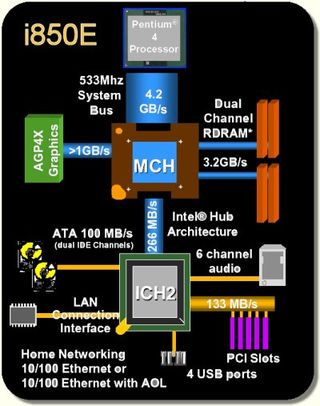The Die Has Been Cast: Pentium 4/2533 vs. Athlon XP 2100+
Old Chipset, New Label: Intel 850E
Since the end of last year, Intel has provided three different chipsets for Pentium 4:
- Intel 845 - SDRAM for Pentium 4. The one that the majority buys (it is slow and somewhat pathetic, but cheaaap!!!).
- Intel 845D - DDR SDRAM for Pentium 4. The one that the majority likes and that performance-aware people buy. It's still inexpensive and performs rather well.
- Intel 850 - RDRAM for Pentium 4. This is the one that nobody likes and only few buy, but it's also the one providing the best performance. Surprisingly, RDRAM has finally reached acceptable price points, so besides the shady business practices of the company that owns the license (Rambus Inc.), the memory is actually acceptable nowadays.
With the introduction of the 'new' processor bus or 'front side bus' clock, Intel had to introduce a new chipset as well, or at least give the child a new name. "i850 is dead! Long live i850E!"
Intel's 'new' i850E chipset is practically nothing else but the 'old' i850, with the only difference that it has been validated for the new processor bus clock. This new 'front side bus' has actually really only been increased from 100 to 133 MHz, but because data is transported at 'quadruple data rate' on this bus, Intel's marketing machine multiplies the actual bus clock with 4 and so the old bus clock was '400 MHz' and the new bus clock is '533 MHz'. What counts is the fact that we have an increase in processor bus bandwidth of 33.3% over previous Pentium 4 models.
OK, we have understood that and we are content, but now comes the "intelish' part of this chipset introduction. Intel deemphasizes two things that one would have considered to go without saying.

- According to Intel, i850E does not officially support the new PC1066 RDRAM , which benefits from a new Rambus memory clock increase from 400 (PC800) to 533 MHz, resulting in a 33.3% increase in memory bandwidth (3200 MB/s to 4266 MB/s in case of the dual channel Rambus platform i850). This new memory is what gives the 533 MHz FSB Pentium 4 processors the real kick.
- To save the time as well as money for a new round of validation, i850E does not officially support the new ICH4 southbridge that includes USB 2.0 . Instead, except for the new 533 MHz front side bus, Intel wants i850E to remain pretty much like the slowly aging i850 chipset (which after all goes back to November 2000), using the slower PC800 RDRAM even though PC1066 RDRAM is available and the old ICH2 and only four USB 1.1 ports instead of ICH4 with its six USB 2.0 USB ports.
Now what do you say? Is that intelish enough for you? Intel officials say clearly, that the Pentium 4 performance platform will be i850E and they always emphasize to us reviewers that they prefer us using this platform when we want to compare P4-performance against AMD's AthlonXP. However, Intel shows utter lack of sincerity when it does not officially support PC1066 RDRAM and feeds the 'performance customer' that buys an i850E platform with an inferior southbridge chip, making sure that this customer has to pay extra money for extra USB 2.0 hardware. In order to make RDRAM boards attractive, motherboard manufacturers such as Asus, Intel, MSI and Iwill will be having their boards equipped with special chips for USB 2.0 support, of course at a premium.
What it boils down to is that Intel doesn't really care much for selling i850E. Instead, the main focus seems to lie on selling all kinds of different flavors of i845, which will be coming up in a couple of weeks. Those i845 versions will also support the 533 MHz FSB and they all come with the fancy ICH4 south bridge chip. They either support DDR-SDRAM or normal SDRAM, they will run the new P4 processors at 2.26, 2.4 and 2.53 GHz and you get 6 USB 2.0 ports as well ... sounds better, doesn't it?
Stay on the Cutting Edge
Join the experts who read Tom's Hardware for the inside track on enthusiast PC tech news — and have for over 25 years. We'll send breaking news and in-depth reviews of CPUs, GPUs, AI, maker hardware and more straight to your inbox.
Current page: Old Chipset, New Label: Intel 850E
Prev Page Joining The Next Round - P4 Gets Yet Another Performance Boost Next Page Only Few 850E Boards Available Right NowMost Popular

